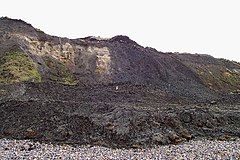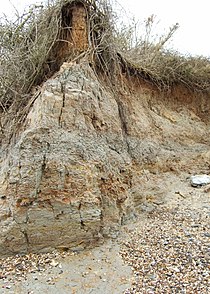
Back صلصال لندن Arabic Formació de l'Argila de Londres Catalan Arcilla de Londres Spanish Argile de Londres French Argilla Londinensis Latin London Clay Dutch London Clay NN Londonleire NB Лондонская глина Russian 伦敦粘土组 Chinese
| London Clay Formation | |
|---|---|
| Stratigraphic range: Early Eocene, | |
 London Clay at Reculver | |
| Type | Formation |
| Unit of | Thames Group |
| Underlies | Bagshot Formation (London Basin), Wittering Formation and Poole Formation (Hampshire Basin and English Channel) |
| Overlies | Harwich Formation |
| Thickness | up to 150 m |
| Location | |
| Region | southern England |
 Geological map of the London Basin; the London Clay is marked in dark brown. | |


The London Clay Formation is a marine geological formation of Ypresian (early Eocene Epoch, c. 54-50 million years ago)[1] age which crops out in the southeast of England. The London Clay is well known for its fossil content. The fossils from the lower Eocene rocks indicate a moderately warm climate, the tropical or subtropical flora. Though sea levels changed during the deposition of the clay, the habitat was generally a lush forest – perhaps like in Indonesia or East Africa today – bordering a warm, shallow ocean.
The London Clay is a stiff bluish clay which becomes brown when weathered and oxidized. Nodular lumps of pyrite are frequently found in the clay layers. Pyrite was produced by microbial activity (sulfate reducing bacteria) during clay sedimentation. Once clay is exposed to atmospheric oxygen, framboidal pyrite with a great specific surface is rapidly oxidized. Pyrite oxidation produces insoluble brown iron oxyhydroxide (FeOOH) and sulfuric acid leading to the formation of relatively soluble gypsum (CaSO4·2H2O, calcium sulfate dihydrate). This latter is more soluble and mobile than iron oxides and can further recrystallize to form larger crystals sometimes called selenite (coming from the moon, but not related to selenium, although the etymology is the same), or "waterstones".
Large septarian concretions, produced by microbial activity (oxidation of organic matter) in the ancient seafloor during clay early diagenesis, are also common. These have been used in the past for making cement. They were once dug for this purpose at Sheppey, near Sittingbourne, and at Harwich, and also dredged, off the Hampshire coast. The clay is still used commercially for making bricks, tiles, and coarse pottery in places such as Michelmersh in Hampshire.
- ^ a b Friedman, Matt; Beckett, Hermione T.; Close, Roger A.; Johanson, Zerina (2016). "The English Chalk and London Clay: two remarkable British bony fish Lagerstätten". Geological Society, London, Special Publications. 430 (1): 165–200. doi:10.1144/SP430.18. ISSN 0305-8719.
© MMXXIII Rich X Search. We shall prevail. All rights reserved. Rich X Search